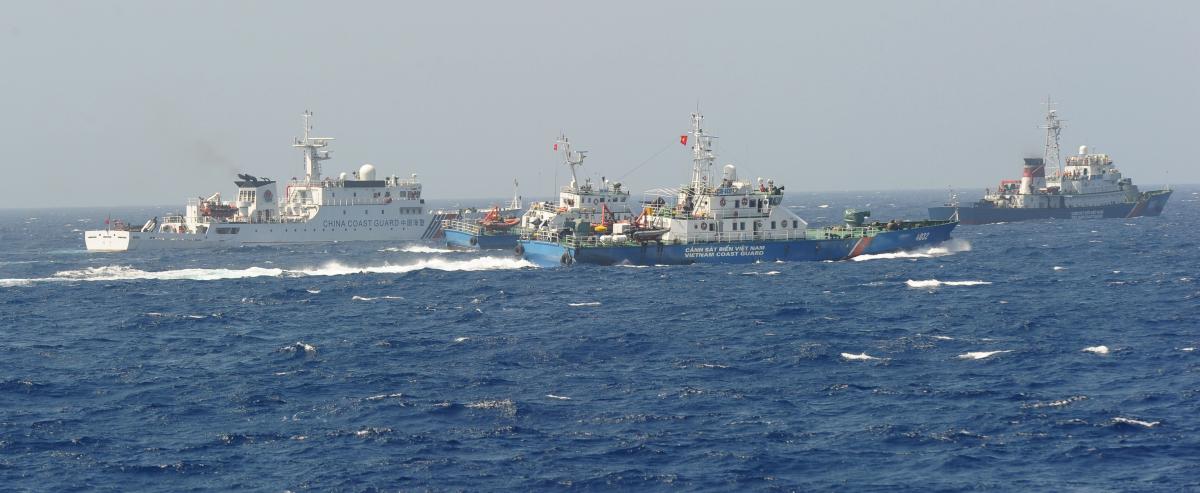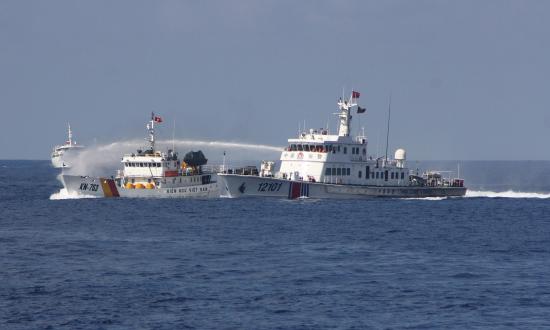The United States and the People’s Republic of China (PRC) are on a trajectory toward conflict. Simply put, the PRC seeks to regain what it sees as China’s proper place in the world, and a major impediment to that aspiration is the United States’ activities in the Pacific, including its support for Taiwan.1 Several factors, to include Chinese history, culture, and military philosophy, guide the Chinese Communist Party’s (CPC’s) decision-making processes as it pertains to waging war. Juxtaposing China’s “Three Warfares” strategy with current events, it is clear that the opening salvos in China’s information war against the United States already are ongoing.2
The span between 1839 and 1949, known in China as the “Century of Humiliation,” is central to how the nation sees the outside world, its place in the world, and its future. According to the CPC, the Century of Humiliation was characterized by unjust wars, unequal treaties, and massive reductions in territory, including the loss of Hong Kong and Taiwan and independence movements in Tibet, Mongolia, and Xinjiang. Although the PRC has regained control of Tibet, Inner Mongolia, and Xinjiang, control of Taiwan has eluded it, in large part because of support from the United States.3
U.S. military support to Taiwan is a major impediment to the realization of the PRC’s wishes for a reunified China.4 It is likely the PRC will pursue a course of action that will render the United States unwilling or unable to continue to guarantee the de facto independence of Taiwan. An understanding of the PRC’s military philosophy helps illustrate how it might achieve this objective.
The Three Warfares
Around 2003, the People’s Liberation Army (PLA) adopted a strategic framework known as the “Three Warfares”: psychological, media, and legal.5 In its 2011 annual report to Congress on military and security developments in the PRC, the Department of Defense defined each area:
• Psychological Warfare seeks to undermine an enemy’s ability to conduct combat operations aimed at deterring, shocking, and demoralizing enemy military personnel and supporting civilian populations.
• Media Warfare is aimed at influencing domestic and international public opinion to build support for China’s military actions and dissuade an adversary from pursuing actions contrary to China’s interests.
• Legal Warfare uses international and domestic law to claim the high ground or assert Chinese interests. It can be employed to hamstring an adversary’s operational freedom and shape the operational space. Legal warfare is also intended to build international support and manage possible political repercussions of China’s military actions. China has attempted to employ legal warfare in the maritime domain and in international airspace in pursuit of a security buffer zone.6
Media Warfare
The PRC is currently conducting media warfare in several ways to influence American audiences. Recent examples include the de facto censorship of employees of the National Basketball Association and software giant Activision-Blizzard, but the most significant activity is in Hollywood.7
The PRC is one of the fastest growing cinema markets in the world, with more than 70,000 screens; this has made the market very attractive for foreign investment.8 Due to legal restrictions, however, theaters are allowed to show only a fixed number of foreign films per year, and only after they have gone through government censors’ strict scrutiny.9 Needless to say, competition is fierce among foreign film studios. This has led to a subtle shift in the content of films over the past decade.
To ingratiate themselves to PRC censors, U.S. film studios are changing the content of their films to have the chance to screen their productions in the PRC. These changes range from shoehorning in Chinese actors, to downplaying or cutting interactions between gay characters, to changing the nationality of antagonists from Chinese to Korean.10 This self-censorship has given the PRC’s State Administration of Press, Publication, Radio, Film, and Television de facto control over content shown to American audiences.
Continually showing the PRC and its actions in a positive light while obfuscating opposing viewpoints could, over time, convince some Americans that the PRC is a benevolent influence, despite its actions worldwide proving otherwise. This shift in perception, could, for example, prime U.S. audiences to accept Chinese attempts to forcefully reintegrate Taiwan.
Legal and Psychological Warfare
The PRC’s psychological and legal warfare activities go hand in glove and are focused heavily on the South China Sea.11 Alleging historical ownership, China has claimed several islands in the region, ignoring protests from neighboring countries and international tribunal rulings to the contrary. The area has significant untapped oil reserves and is a major global trade route; gaining exclusive control of the South China Sea would contribute a great deal to the PRC achieving regional and global hegemony. The ways it has attempted to do so are prime examples of psychological and legal warfare in action.
The PRC initially used legal warfare in the South China Sea by appealing to international legal bodies to legitimize its territorial claims.12 When those bodies have rejected the claims, the PRC has branded them as illegitimate and refused to abide by their findings.13This ultimately undermines the legitimacy of these bodies and decreases stability in the region, as neighboring nations become more uncertain of the legal status of the South China Sea.14 Although the United States has not been directly affected by the PRC’s actions, it is incurring costs in the form of increased freedom of navigation operations.
The PRC’s psychological warfare activities in the South China Sea chiefly are aimed at deterring neighboring countries from encroaching on its claimed territory. When neighboring nations’ vessels and aircraft come into contested areas, they have been met with violent Chinese resistance, including PRC vessels ramming Vietnamese fishing boats, disrupting Malaysian oil exploration activities, and verbally harassing Filipino military pilots over the radio.15 These actions can be seen as psychological operations actions (PsyActs). PsyActs are actions conducted to influence target audience thoughts and perceptions in the pursuit of an objective; in this case, the PRC reacts violently to supposed infringements on its sovereignty to create the perception among its neighbors that the South China Sea is indeed legitimate Chinese territory.16 Continued psychological warfare actions have the potential to provide the PRC the space to continue its expansion of artificial islands in the area, further destabilizing the region and increasing costs to the United States and its partners.
The PRC is trying to claim what it perceives to be its rightful place in the world, and this is likely to bring it to blows with the United States, its main rival for global hegemony. It currently is trying to “win without fighting” by using its Three Warfares doctrine. Infiltration of the entertainment industry, attempts to legitimize its claims in the South China Sea, and continued harassment of U.S. partners and allies in the Pacific are part of a series of planned activities intended to weaken U.S. and allied resolve prior to a forced reunification with Taiwan. Abundant indicators suggest the PRC is attempting to levy costs on the United States to achieve strategic goals. It is incumbent on U.S. leaders to decide whether the PRC will impose its worldview unchecked, or if the United States will rise to counter it.
1. James Griffiths, “From the Qing Empire to the People’s Republic, China’s Worries about Separatism Run Deep,” CNN, 29 June 2020, www.cnn.com/2020/06/29/asia/china-separatism-independence-intl-hnk/index.html.
2. Stefan Halper, China: The Three Warfares (Washington, DC: Office of the Secretary of Defense, 2013), 28.
3. Alison Kaufman, “Testimony before the US-China Economic and Security Review Commission; Hearing on ‘China’s Narratives Regarding National Security Policy,’” USCC.gov, 10 March 2011, www.uscc.gov/sites/default/files/3.10.11Kaufman.pdf.
4. Griffiths, “From the Qing Empire.”
5. Halper, China: The Three Warfares, 27.
6. Office of the Secretary of Defense, Military and Security Developments Involving the People’s Republic of China (Washington, DC : Department of Defense, 2011), 26, www.globalsecurity.org/jhtml/jframe.html#https://www.globalsecurity.org/military/library/report/2011/2011-prc-military-power.pdf.
7. Mark Dreyer, “China NBA: How One Tweet Derailed the NBA’s China Game Plan,” BBC, 10 October 2019, www.bbc.com/news/world-asia-china-49995985; and Peter Allen Clark, “What to Know about Blizzard, Hong Kong, and the Controversy Over Politics in Esports,” Time, 21 October 2019, https://time.com/5702971/blizzard-esports-hearthstone-hong-kong-protests-backlash-blitzchung/.
8. Lai Lin Thomala, “Number of Movie Theaters in China from 2012 to 2019,” Statista.com, 21 August 2020, www.statista.com/statistics/260284/number-of-movie-theaters-in-china/#:~:text=Number%20of%20movie%20theaters%20in%20China%202012%2D2019&text=The%20statistic%20shows%20the%20number,billion%20movie%20audience%20in%20China.
9. Martha Bayles, “Hollywood’s Great Leap Backward on Free Expression,” Atlantic, 15 September 2019, www.theatlantic.com/ideas/archive/2019/09/hollywoods-great-leap-backward-free-expression/598045/.
10. Frank Langfitt, “How China’s Censors Influence Hollywood,” NPR, May 2012, www.npr.org/sections/parallels/2015/05/18/407619652/how-chinas-censors-influence-hollywood; Joanna Robinson, “Did You Catch All the Ways Hollywood Pandered to China This Year?” Vanity Fair, 5 August 2016, www.vanityfair.com/hollywood/2016/08/did-you-catch-the-ways-hollywood-pandered-to-china-this-year; and Ben Fritz, “Reel China: Hollywood Tries to Stay on China’s Good Side,” Los Angeles Times, 16 March 2011, www.latimes.com/entertainment/la-et-china-red-dawn-20110316-story.html.
11. Halper, China: The Three Warfares, 12–13.
12. Zhang Yesui, “Note Verbale to the Secretary-General of the United Nations from the People’s Republic of China,” UN.org, 7 May 2009, www.un.org/depts/los/clcs_new/submissions_files/mysvnm33_09/chn_2009re_mys_vnm_e.pdf.
13. Jane Perlez, “Tribunal Rejects Beijing’s Claims in South China Sea,” New York TImes, 12 July 2016, www.nytimes.com/2016/07/13/world/asia/south-china-sea-hague-ruling-philippines.html.
14. Justin Nankivell, China’s Use of Lawfare in the South China Sea Dispute (Washington, DC: Office of the Secretary of Defense, 2013), 424–25.
15. Alexander Neill, “South China Sea: What’s China’s Plan for Its ‘Great Wall of Sand’?” BBC, 14 July 2020, www.bbc.com/news/world-asia-53344449; and “South China Sea: ‘Leave Immediately and Keep Far Off,” BBC News, 11 August 2018, www.youtube.com/watch?v=dodbqgKn8js.
16. Psychological Operations Proponent, Field Manual 3-05.301, Psychological Operations Process Tactics, Techniques, and Procedures (Washington, DC: Department of the Army, 2007), 58.






